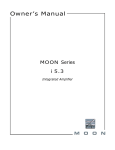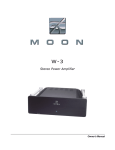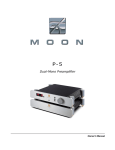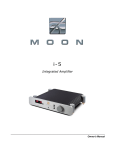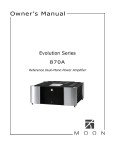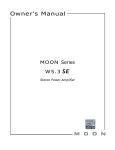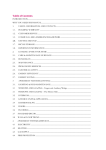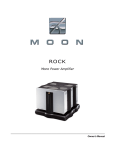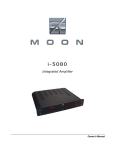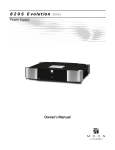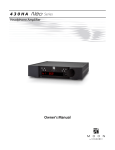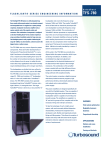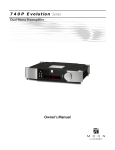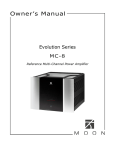Download User manual
Transcript
i-3 Integrated Amplifier ___________________________________________________________________________ Owner’s Manual MOON i-3 Integrated Amplifier Table of Contents Congratulations ............................................... 3 Unpacking and Warnings ................................... 3 Introduction .................................................... 4 Installation & Placement ................................... 4 Front Panel Controls ......................................... 5 Rear Panel Connections ..................................... 6 Operating the i-3 ............................................. 7 Remote Control Operation ................................. 8 Specifications .................................................. 9 www.simaudio.com IMPORTANT: Please read this entire manual before using this product. Installation and operating instructions inside. ____________________________________________________________________________________ MOON i-3 Integrated Amplifier Congratulations! Thank you for selecting the MOON i-3 Integrated Amplifier as a part of your music/cinema system. This component has been designed to offer state-of-the-art high-end performance in an elegant package, while retaining all the sonic hallmarks on which Simaudio has made its reputation. We have spared no effort to ensure that it is amongst the finest two-channel Integrated Amplifiers available. We have been building high-performance audio equipment for over 25 years, and the know-how gained through our cumulative experience is an important reason why MOON integrated amplifiers are so musically satisfying. The performance of your i-3 will continue to improve during the first 400 hours of listening. This is the result of a “break-in” period required for the numerous high quality electronic parts used throughout this integrated amplifier. Before setting up your new MOON i-3, we encourage you to please read this manual thoroughly to properly acquaint yourself with its features. We hope you enjoy listening to the MOON i-3 Integrated Amplifier as much as the pride we have taken in creating this fine audio product. We understand the power and emotion of music and build our products with the goal of faithfully capturing these elusive qualities. Unpacking The MOON i-3 Integrated Amplifier should be removed from its box with care. The following accessories should be included inside the box with your Integrated Amplifier: 9 AC power cable 9 ‘SRM’ remote control with three ‘AAA’ batteries (USA and Canada only) 9 This owner’s manual 9 Warranty and product registration information (USA and Canada only) As soon as the integrated amplifier is safely removed from its box and placed down, perform a thorough physical inspection and report any physical damage to your dealer immediately. We suggest that you keep all of the original packaging, storing it in a safe, dry place in the event that you’re required to transport the integrated amplifier. The customized packaging is specially designed to protect the MOON i-3 Integrated Amplifier from potential damage that may occur during shipping. ________________________________________________________________ WARNING! To reduce the risk of fire or electric shock, do not expose this product to rain or moisture. Do not attempt to “lift the ground” by removing the ground pin from the AC cable. Make sure that your household electrical wiring supports proper AC grounding techniques before plugging in this product. Keep the heat sinks and top cover free of dust to allow for proper heat dissipation. Never expose this product to extreme temperatures. Always connect the audio signal path cables prior to connecting the AC mains. CAUTION! No user-serviceable parts inside. Do not remove top cover, as severe electrical shock may result. IMPORTANT! Make sure that your local AC voltage complies with the unit’s label. Damage caused by plugging this component into an AC receptacle of the wrong voltage will not be covered by warranty. ____________________________________________________________________________________ Congratulations / Unpacking 3 MOON i-3 Integrated Amplifier Introduction Your MOON i-3 integrated amplifier incorporates many significant design features to achieve its “world class” level of performance. This is an abbreviated list of the more important features: Proprietary “Advanced Renaisance” Technology which eliminates feedback. The results are as follows: Real-time amplification is achieved since interactions from the speaker back to the amplifier are virtually eliminated; More accurate musical reproduction with respect to tonality; Virtually non-existent transient intermodulation distortion (which is far more degrading to sonic perfomance than harmonic distortion); The elimination of common phase errors resulting from feedback. An oversized power supply using a custom proprietary toroidal transformer design with lower magnetic, electrical and thermal loss, yielding an improved transfer and lower regulation factor, resulting in increased current speed and better dynamics. An extremely short capacitor-free signal path measuring less than nineteen inches in length, from input RCA connectors to output binding posts, for a faster transient response. A gain section that uses a Crystal microprocessor functioning as a “shunt to ground” that doesn't degrade sonic performance regardless of the selected setting. J-FET input devices in the preamplifier section. Precision matched Bipolar output devices in the amplifier section, which offer superb linearity throughout the entire audio frequency spectrum. One single-ended audio input which functions as a “pass-through”, bypassing the gain stage to accommodate a component such as a home-theater processor, whose own volume control is used instead. Class A output to 5 watts for greater efficiency. A symmetrical circuit design with accurate matching of the very finest high quality electronic components. Heavy duty gold-plated output binding posts. Pure copper circuit board tracings with extremely low impedance characteristics. Designed to be powered up at all times for optimal performance. Low operating temperature for a longer than normal life expectancy. Installation & Placement The MOON i-3 requires reasonable ventilation to maintain an optimum and consistent operating temperature. As a result, it should be placed in a location with empty space around it for proper heat dissipation. As well, it should be placed on a solid level surface. You should avoid placing it near a heat source or inside a closed cabinet that is not well ventilated as this could compromise the integrated amplifier’s performance and reliability. The i-3 uses a toroidal transformer; even though it is well shielded, you should not place the Integrated Amplifier too close to source components sensitive to EMI, such as turntables and phono preamplifiers. You should never place another component directly on top of this integrated amplifier. Since household dust is an excellent insulator of heat, we suggest that you clean both of the curved side-mounted heat sinks on a regular basis. A smooth nylon brush with long bristles (ie. paint brush) is recommended for this task. Finally, you should make all of your audio signal connections prior to making the AC connection between the i-3 and the AC wall outlet. ____________________________________________________________________________________ Introduction / Installation & Placement 4 MOON i-3 Integrated Amplifier Front Panel Controls Figure 1: MOON i-3 Front panel The front panel will look similar to Figure 1 (above). The large digital display window indicates the relative gain setting (from ‘0’ to ‘50’) for both the left and right channels. As well, whenever you change the selected input source, it’s number will appear in the window for 3 seconds before reverting back to the gain setting. The “Stand by/On” button disengages the input section from the rest of the i-3’s circuitry and turns off the digital display. However, when in “Stand by” mode all audio circuitry remains powered up to help maintain optimal performance. When switching back from “Standy by” to the “on” mode, both the ‘input’ and gain level settings will be memorized from the previous listening session. The blue pilot LED will not be illuminated when the i-3 is in “Stand by” mode. When the i-3 is operational, holding down the “Stand by/On” for two (2) seconds will turn off the front panel digital display. Repeating this procedure will turn the front panel digital display back on. The sonic performance of the MOON i-3 may improve slightly when the display is turned off. The “Input” selector button allows you to choose which input source you wish to listen to. The MOON i-3 integrated amplifier has six (6) inputs. The A4 input can be configured as a ‘pass-through’ which bypasses the i-3’s gain control section, allowing you to control the gain setting via the connected source component’s own volume control – a home theater processor for example. In ‘pass-through’ mode, adjusting the volume on the i-3 will have no effect whatsoever when the A4 input is selected. To put the A4 input into ‘pass-through’ mode, simply press and hold down the “Input” selector button for approximately 5 seconds; you don’t have to be on the A4 setting to do this. To reconfigure the A4 input to function like the five (5) other inputs, repeat the aforementioned procedure. As well, powering down the i-3 via the rear panel rocker switch will reset the the A4 to the factory default ‘normal’ mode. Pressing the “Input” selector button allows you to sequentially cascade through each of the possible inputs in the following order: CD, A1, A2, A3, A4 and A5. Holding down the “Input” will allow only a single change of the selected input. You must press the button again to select the next input. The “Vol Up” and “Vol Down” buttons control the gain setting, which ranges from ‘0’ (no output) to ‘50’ (full output). This control doesn’t function like a typical volume: When you press either of these volume control buttons, you’re selecting a specific gain setting on a shunt-to-ground based microprocessor circuit. This gain circuit, known as RGB-cs, doesn’t degrade the audio signal regardless of the setting, unlike all potentiometer based circuits. The range of fifty (50) unique gain settings is based on neither a linear nor logarithmic scale. Instead, we decided on relatively small variations for each of the lower position settings from ‘1’ to ‘35’. The variations are somewhat larger from positions ‘36’ through ‘50’. ____________________________________________________________________________________ Front Panel Controls 5 MOON i-3 Integrated Amplifier Rear Panel Connections Figure 2: MOON i-3 Rear panel The rear panel will look similar to Figure 2 (above). There are five (5) pairs of single-ended inputs on RCA connectors labeled CD, A1, A2, A3. A4 and A5. The left channel inputs are located on top and the corresponding right channel inputs are located directly below. The A4 input, as previously mentioned, bypasses the gain stage and is intended to be used with a component, such as a home theater processor, that has its own volume/gain control. The MOON i-3 integrated amplifier has two pairs of non-amplified outputs; One single-ended pair of RCA connectors labeled ‘Pre Out’, located next to the A4 input, is designated for output to a power amplifier with single-ended RCA inputs in the event that you wish to use your MOON i-3 as a preamplifier only. The output level of the ‘Pre Out’ is dependant on the volume control setting. A second single-ended pair if RCA connectors labeled ‘Tape Out’, located next to the ‘Pre Out’ connectors, is intended as an input to a recording device such as a cassette tape deck or CD-Recordable Player. Keep in mind that the output level on the ‘Tape Out’ is fixed and cannot be adjusted by the i-3’s volume control. All RCA input and output connectors on the rear panel have been color coded: ‘white’ for the left channel and ‘red’ for the right channel. On each side of the group of RCA connectors, there is a pair of gold-plated binding posts. Connect your loudspeakers, with the cables of your choice, to these binding posts. Take care to respect the polarity (“+” , “-” ) of the output. Don’t hesitate to use high quality interconnects and speaker cables. performance of your system. Poor quality cables can degrade the overall sonic Finally on the right side is the main power switch (“0”=off, “1”=on), the “AC Fuse” socket cover, and the IEC receptacle for the included AC power cord. Alternatively, you may use a dedicated high-performance AC power cord designed for power amplifiers. All rear panel connectors have been chosen because they provide the best possible connections for your unit. A poor contact will degrade the signal substantially, and plugs and sockets should all look clean and free of dirt and corrosion. The easiest way to clean them is to remove the cables from their sockets and push them back in again. This procedure requires that your Integrated Amplifier and the rest of your components be completely turned off. Not heeding this warning may result in serious damage to your equipment. Special contact cleaning fluids and enhancers should not be used, as they deposit a difficult to remove residue which degrades the performance of your components. ____________________________________________________________________________________ Rear Panel Connections 6 MOON i-3 Integrated Amplifier Operating the i-3 We recommend that you leave your MOON i-3 Integrated Amplifier powered up at all times to maintain optimal performance. In the event that you plan to be away from your home for a few days, powering off the Integrated Amplifier may not be a bad idea. Once fully “broken-in”, please keep in mind that your i-3 will require several hours of playing time before it reaches its peak performance after you’ve powered it up again. Making the AC Connection Connect the supplied AC power cable to the IEC receptacle, located on the rear panel of the integrated amplifier’s chassis. Ensure that the AC wall outlet you use has a functioning ground. For the best sonic performance, it is preferable that you plug your MOON i-3 directly into a dedicated AC outlet and avoid using an extension cord. In order to obtain the maximum performance from your audio system, we strongly recommend that the detachable power cord not come into physical contact with any of the interconnect and speaker cables running to and from your i-3. In the event that this can’t be avoided, you should ensure that any cables coming into contact with each other are crossed at ninety degree angle to minimize the contact area. Turning on your MOON i-3 for the first time Prior to turning the integrated amplifier on for the first time, make sure that every cable is properly connected to avoid any problems. Then turn on your integrated amplifier in the following manner: 1) Flick the main rocker switch labeled “POWER” to the ‘1’ (on) position on the rear of the i-3. 2) Press the push button labeled “Stand by/On” on the i-3. The blue LED will illuminate and the digital display will indicate a gain setting of ‘0’ and the ‘CD’ as the default input. On and Off Sequence To avoid having any annoying noises (ie. “thumps” and “pops”) emanate from your speakers when powering your i-3 on or off, you should 1) Always power up your i-3 integrated amplifier after powering up your source component(s). 2) Always power down your i-3 before powering down your source component(s). ____________________________________________________________________________________ Operating the i-3 7 MOON i-3 Integrated Amplifier Remote Control Operation The MOON i-3 Stereo integrated amplifier uses the ‘SRM’ simple function, all aluminum remote control (figure 3). It operates on the Philips RC-5 communication protocol and is can be used with other Simaudio MOON components. The ‘SRM’ remote uses three AAA batteries (included). To install them, use the supplied Allen key to remove the three screws located on the back plate; insert the batteries in the correct direction and then screw the back plate back into place. The POWER button located on the upper left will switch the integrated amplifier to either ‘Stand by’ or ‘On’ mode. The INPUT button performs in exactly the same way as the ‘Input’ button located on the i-3’s front panel, sequentially cascading through each of the integrated amplifier’s inputs. The VOL+ and VOL– buttons increase and decrease, respectively, the volume level. The and buttons control channel balance; Pressing the left arrow button causes a decrease in the volume level of the right channel; pressing the right arrow button causes a decrease in the volume level of the right channel. Figure 3: SRM Remote Control The MUTE button, located in the middle of the volume and balance buttons, triggers a decrease in the output gain setting to a factor of 10% of the current setting. For example, if your current setting was ‘30’ and you pressed the “Mute” button, the gain setting will drop to ‘3’. Pressing the “Mute” button a second time will reinstate the output gain level back to ‘30’. ____________________________________________________________________________________ Remote Control Operation 8 MOON i-3 Integrated Amplifier Specifications Configuration ......................................................... Power Supply Transformer ....................................... Power Supply Capacitance ...................................... Class Of Operation - Preamplifier .............................. Class Of Operation - Amplifier .................................. Single-ended inputs ................................................. Input Device Type - Preamplifer ............................... Input Sensitivity ..................................................... Input Impedance ................................................... Tape Output .......................................................... Preamplifier output ................................................. Output Device Type.................................................. Output Binding Posts ............................................... Output Power @ 8Ω ................................................ Output Power @ 4Ω ................................................ Output Power @ 2Ω ................................................ Output Impedance .................................................. Damping Factor ...................................................... Gain Control ........................................................... Gain ....................................................................... Dynamic Headroom ................................................. Signal-to-noise Ratio .............................................. Maximum Output Voltage ........................................ Slew Rate ............................................................... Maximum Current – Peak ........................................ Maximum Current – Continuous .............................. Frequency Response .............................................. Crosstalk @ 1kHz ................................................... Intermodulation Distortion ...................................... THD (20Hz - 20kHz @ 1 watt) ................................ THD (20Hz - 20kHz @ 100 watts) .......................... Remote Control ...................................................... AC Power Requirements ......................................... Fuse Replacement - 120V ....................................... Fuse Replacement - 230V ....................................... Shipping Weight ..................................................... Dimensions (W x H x D, inches) .............................. Stereo 0.6kVA 40,000µF Class A Class A/B 6 (RCA) J-FET 400mV – 3.0V RMS 12,000Ω 1 (RCA) 1 (RCA) Bipolars – 4 per channel Gold-Plated - 1 set per channel 100 Watts per channel 160 Watts per channel 200 Watts per channel 0.04Ω > 200 RGB cs – “Shunt-To-Ground” 37dB 6dB 98dB @ full power 30 Volts 20V/µs 22 amperes 12 amperes 10Hz - 80kHz +0/-3dB -65dB Unmeasureable < 0.1% < 0.15% All Aluminum Simple-Function 120V / 60Hz or 240V / 50Hz 4A long fast blow (3AG size) 2A long fast blow (3AG size) 23 lbs / 10 Kgs 17 x 3 x 15.5 ____________________________________________________________________________________ Specifications 9










